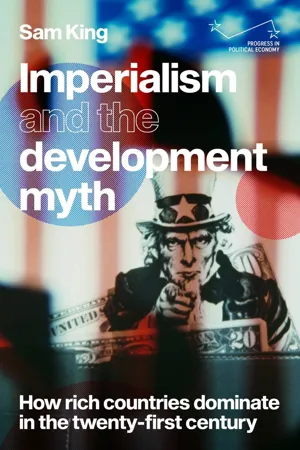![]()
Part I
Two worlds
![]()
1
Income polarisation in the neoliberal period
It is common for contemporary Marxist writers to argue that the neoliberal period increased the income and wealth gap – or the polarisation of income and wealth – between rich and poor people, or between the working class and capitalist class. It is less common to acknowledge the growing polarisation between the small group of imperialist societies and the much larger group of Third World societies.1 Many First World Marxists argue that the terms ‘First World’ and ‘Third World’ are meaningless, dated terms that do not correspond to today’s reality.2 That the imperialist societies are almost the same group of countries, occupying almost the same position as a hundred years ago, is something rarely noted and even less analysed. Yet such international polarisation has not only persisted since the Second World War but has grown substantially – especially during the neoliberal period.
The international polarisation represents, alongside the polarisation of income and wealth between classes, a crucial form of the general trend towards the concentration and centralisation of capital that Marx anticipated.3 It is also an important concrete form taken by the growing inequality between classes. As such, no accurate analysis of the international class struggle is possible today without taking the worldwide division and polarisation between societies into account.
At the second congress of the Communist International (Comintern) in 1920, Lenin emphasised the division of the world into a small minority of oppressor nations and ‘the vast majority’ of the world’s population who lived in the oppressed societies. He estimated that ‘about 70 percent of the world’s population belongs to the oppressed nations’.4 Since then polarisation has dramatically increased. By 2015 not 70 per cent but 85 per cent of the world’s population lived in poor countries. The relative size of the rich country population – 13.4 per cent of the world’s people – has halved compared with Lenin’s estimate. Strikingly, today truly ‘middle-income’ or ‘Second World’ countries are almost non-existent, accounting for just 1.6 per cent of world population. The world’s states are clearly divided into top and bottom parts, with a large, almost unpopulated gap in between (Table 1.1).
Table 1.1 First, Second and Third World population and income, USD, 2015
| First World:
income above
$25,000 | Second World:
income
$15,700–$25,000 | Third World:
income below
$15,700 | World |
Number of states and territories | 32 | 14 | 148 | 194 |
Population (thousand) | 996,667 | 100,412 | 6,239,386 | 7,336,465 |
GDP (trillion) | $44.24 | $2.00 | $27.74 | $73.98 |
Share of world GDP | 59.8% | 2.7% | 37.5% | |
GDP per capita | $44,392 | $19,909 | $4,446 | $10,084 |
GDP per capita – percentage of First World average | 100% | 44.9% | 10% | 22.7% |
Share of world population | 13.6% | 1.4% | 85% | |
Gross domestic product (GDP) in US dollars is the most meaningful measure of the current health and power of each national capitalist class. Unlike so-called purchasing power parity (PPP), which exists only as a statistical construction, USD GDP measures (however imperfectly) income that capitalists and workers actually receive for the sale of commodities they own. US dollars command purchasing power over goods sold on the world market.
By measuring national income in USD (or its exchange equivalent in other national currencies) we gain an indication of the quantity of goods that can be obtained on the world market in exchange for a given country’s own labour product. This comparison of labour product for labour product is an objective measure not of a given country’s value creation, but of how much value it can capture. Comparing per capita GDP is useful as it compares the world market value (i.e. price) of labour product per person. This has a rough equivalence to per worker and per hour, as there is a general correlation between the size of population and workforce. Gross GDP, on the other hand – that is, total national product – can simply indicate a large or small population or country but, unlike GDP per capita, has no correlation with the degree of concentration of capital, rates of profit or individual income.
Gross Indian GDP (over USD 2 trillion) for example, is very large, larger than Italy and not far off France. In a certain sense, this does correspond to power. The Indian state apparatus is certainly regionally powerful in relation to its smaller neighbours that have a similar level of development. However, the gross figure gives no indication of the competitive position of Indian capital on the international market.
World income polarisation can be visually represented by graphing the income level of the twenty most populous countries in the world (Figure 1.1). These countries, representing more than 5 billion people or 70 per cent of world population, are strikingly polarised into rich and poor countries, with no middle countries at all. If the graph were bigger, it would show that the largest fifty states in the world all fall into the same pattern. They achieve either First World or Third World per capita income. The largest middle-income or Second World state, Saudi Arabia (population 31.5 million), is the fifty-first country in the world by population. The next biggest, Taiwan (population 23.5 million), is the sixty-second, followed by Greece (population 11 million), the s...
